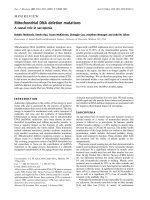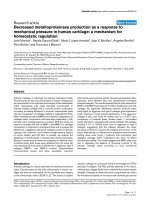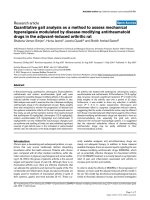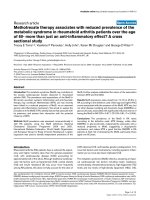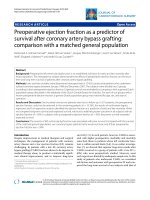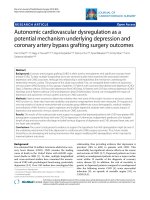Báo cáo y học: "Plasma DNA concentration as a predictor of mortality and sepsis in critically ill patients" pptx
Bạn đang xem bản rút gọn của tài liệu. Xem và tải ngay bản đầy đủ của tài liệu tại đây (196.09 KB, 7 trang )
Open Access
Available online />Page 1 of 7
(page number not for citation purposes)
Vol 10 No 2
Research
Plasma DNA concentration as a predictor of mortality and sepsis
in critically ill patients
Andrew Rhodes
1
, Stephen J Wort
1
, Helen Thomas
2
, Paul Collinson
2
and E David Bennett
1
1
Intensive Care Unit, St Georges's Hospital, London, UK
2
Department of Chemical Pathology, St Georges's Hospital, London, UK
Corresponding author: Andrew Rhodes,
Received: 30 Nov 2005 Revisions requested: 6 Jan 2006 Revisions received: 13 Mar 2006 Accepted: 16 Mar 2006 Published: 13 Apr 2006
Critical Care 2006, 10:R60 (doi:10.1186/cc4894)
This article is online at: />© 2006 Rhodes et al., licensee BioMed Central Ltd.
This is an open access article distributed under the terms of the Creative Commons Attribution License ( />),
which permits unrestricted use, distribution, and reproduction in any medium, provided the original work is properly cited.
Abstract
Introduction Risk stratification of severely ill patients remains
problematic, resulting in increased interest in potential
circulating markers, such as cytokines, procalcitonin and brain
natriuretic peptide. Recent reports have indicated the
usefulness of plasma DNA as a prognostic marker in various
disease states such as trauma, myocardial infarction and stroke.
The present study assesses the significance of raised levels of
plasma DNA on admission to the intensive care unit (ICU) in
terms of its ability to predict disease severity or prognosis.
Methods Fifty-two consecutive patients were studied in a
general ICU. Blood samples were taken on admission and were
stored for further analysis. Plasma DNA levels were estimated by
a PCR method using primers for the human β-haemoglobin
gene.
Results Sixteen of the 52 patients investigated died within 3
months of sampling. Nineteen of the 52 patients developed
either severe sepsis or septic shock. Plasma DNA was higher in
ICU patients than in healthy controls and was also higher in
patients who developed sepsis (192 (65–362) ng/ml versus 74
(46–156) ng/ml, P = 0.03) or who subsequently died either in
the ICU (321 (185–430) ng/ml versus 71 (46–113) ng/ml, P <
0.001) or in hospital (260 (151–380) ng/ml versus 68 (47–
103) ng/ml, P < 0.001). Plasma DNA concentrations were
found to be significantly higher in patients who died in the ICU.
Multiple logistic regression analysis determined plasma DNA to
be an independent predictor of mortality (odds ratio, 1.002
(95% confidence interval, 1.0–1.004), P = 0.05). Plasma DNA
had a sensitivity of 92% and a specificity of 80% when a
concentration higher than 127 ng/ml was taken as a predictor
for death on the ICU.
Conclusion Plasma DNA may be a useful prognostic marker of
mortality and sepsis in intensive care patients.
Introduction
Prognosis of patients is important in risk stratification and for
efficient use of hospital resources. Predicting the outcome of
patients in the intensive care environment is of particular sig-
nificance, to ensure that resources are used appropriately.
Numerous biomarkers have been evaluated to predict morbid-
ity and mortality in the intensive care setting, although none
have proved entirely useful. Examples of such biomarkers
include cytokines [1], procalcitonin [2], C-reactive protein [3],
brain natriuretic peptide [4] and cardiac troponin I [5].
Interest has recently developed in the use of plasma DNA, or
cell-free nucleic acid, as a prognostic marker [6]. Plasma DNA
can be defined as fragments of DNA that are detectable in the
extracellular fluid. There are two types of DNA present in the
circulation; 'free' DNA present in the plasma (which includes
DNA packed into nucleosomes from apoptotic cells) or DNA
associated with circulating lymphocytes (considered a minor
component) [7].
Relatively little is known about free circulating DNA, but
numerous studies have established that baseline levels are
present in normal, healthy populations, albeit at very low levels
[8]. It has been suggested that DNA enters the circulation fol-
lowing cell death. This can be as a result of cell necrosis or of
programmed cell death (apoptosis). In addition, the clearance
mechanism of DNA from the circulation is poorly understood,
although experimental studies using animals have produced
evidence suggesting that the liver and the kidneys are prime
candidates for its removal [9]. An increase in plasma DNA con-
ICU = intensive care unit; IL = interleukin; PCR = polymerase chain reaction; ROC = receiver operator curve; SOFA = Sepsis-related Organ Failure
Assessment.
Critical Care Vol 10 No 2 Rhodes et al.
Page 2 of 7
(page number not for citation purposes)
centration may therefore occur either due to increased libera-
tion from cells or to a decrease in clearance efficiency.
Increased plasma levels of DNA have been found in conditions
associated with cell death, including cancer [8], pregnancy
[10], stroke [6], myocardial infarction [11] and trauma [12]. In
addition, the plasma DNA concentration in trauma patients is
directly related to the severity of injury [12]. Furthermore, the
plasma DNA concentration taken soon after the accident is
predictive of death with a sensitivity and a specificity of 100%
and 81%, respectively [12]. A prognostic value has also been
shown in patients with acute myocardial infarction [11] and
acute stroke [6].
Sepsis is a major cause of morbidity and mortality in patients
in the ICU [13]. Sepsis is associated with cell necrosis and
apoptosis [14]. Indeed, plasma DNA levels have been shown
to be increased in patients with sepsis [15]. Furthermore, ele-
vated nucleosome levels, a marker of cell apoptosis, are
increased in patients with severe sepsis and septic shock
[16]. The aim of the present study was to investigate the prog-
nostic value of circulating levels of cell-free DNA in patients
with sepsis in the intensive care setting.
Materials and methods
Unselected, consecutive admissions to St George's Hospital
General Intensive Care Unit (ICU) were prospectively entered
into this study. The General ICU at St George's Hospital
caters for general medical and general surgical patients with
no cardiac or neurosurgical specialties. Informed consent from
the patients was waived by the local research/ethics commit-
tee as this was an observational study looking at plasma DNA,
a new variable measured from blood samples that were taken
as part of standard clinical practice. All blood samples were
taken from indwelling intra-arterial access on admission to the
ICU.
Demographic and medical data were collected that included
details on the reason for admission, complications in the first
24 hours, the length of stay, ICU and hospital mortality, and the
Sepsis-related Organ Failure Assessment (SOFA) score [17].
Patients were followed up three months after discharge from
the ICU. Severe sepsis and septic shock were defined accord-
ing to previously published criteria [18].
Ethylenediamine tetraacetic acid samples were collected from
each patient. All samples were separated within 3 hours. In
addition, samples were also taken from 10 healthy volunteers
to determine the plasma DNA concentrations in a healthy pop-
ulation. To ensure cell-free plasma collection, samples were
initially centrifuged for 6 minutes at 3,000 rpm, followed by
separation into a 1.5 ml clear polypropylene tube taking care
not to disturb the buffy coat layer. The newly separated aliquot
was centrifuged for a further 10 minutes at 14,000 rpm, after
which the upper portion of plasma was removed by a pasteur
pipette (approximately 500 µl), was placed into a further clear
tube and was frozen at -20°C prior to extraction.
Extraction of DNA from 134 plasma samples was accom-
plished using the High Pure PCR Template Preparation kit
(Roche, Lewes, UK). The only adaptation made to the manu-
facturer's protocol was the use of 200 µl plasma rather than
whole blood. Plasma DNA was detected by quantitative PCR
(Roche Lightcycler; Roche, Lewes, UK), using primers for the
β-globin gene, a housekeeping gene involved in the formation
of a functioning haemoglobin molecule. This gene has been
used successfully in previous studies measuring plasma DNA
using similar PCR-based techniques [12]. The generation of a
plasma DNA standard curve was accomplished using human
genomic DNA.
The 101-base-pair amplicon was detected using primer
sequences and were verified in the Genbank database (acces-
sion number U01317
) [12]. The primer sequence and concen-
tration were obtained such that a concentration of 300 nmol/l
was present in the final mixture [12]. The annealing tempera-
ture of the primers was set at 60°C. The optimal magnesium
chloride (MgCl
2
) concentration was determined by assessing
at which concentration the lowest crossing point, the highest
fluorescence intensity and the steepest curve slope were
observed. Absolute quantification of plasma DNA was
achieved using the Lightcycler software (version 3.5.2; Roche,
Lewes, UK). On each run, a standard curve was repeated in
duplicate as well as with the inclusion of a 'positive' genomic
DNA control and a negative (de-ionised water) control.
Statistical analyses
Data are presented either as absolute numbers, as medians
with the interquartile range or as percentages. Statistical sig-
nificance was set at a level of P = 0.05. Statistical variance
between groups was assessed by the Fisher's exact test for
discrete variables and by the Mann-Whitney U test for contin-
uous variables. Spearman-rank correlation was used for all
correlation data. A backwards logistic regression model was
set up to identify factors that had independent predictive value
for mortality on the ICU. All the factors (described later) were
entered into the model. The least significant factor was then
removed from the model and the calculation repeated until all
remaining factors remained significant. Receiver operator
characteristic (ROC) curve analysis was used to estimate an
optimal cutoff value for the use of plasma DNA measurements
for predicting death as well as the sensitivity and specificity of
the test at this level.
Results
Fifty-two patients were recruited into the study. Baseline char-
acteristics of these patients are presented in Table 1. The
median SOFA score on admission to the ICU was 5.5 (3–8).
Nineteen of the 52 (37%) patients had a diagnosis of either
sepsis or septic shock within the first 24 hours of admission.
Available online />Page 3 of 7
(page number not for citation purposes)
Thirteen of the 52 (25%) patients died in the ICU and 16
patients (31%) died in hospital. The median length of stay of
patients on the ICU was 5 (2–12) days and the median length
of stay in hospital was 14 (7–30) days. The 10 healthy con-
trols had a median plasma DNA level of 17 (14–19) ng/ml. The
median plasma DNA level for all patients on admission to the
ICU was significantly higher than that of the controls (80 (48–
260) ng/ml, P = 0.001) (Figure 1).
Plasma DNA and severity of illness
There were no differences seen in the plasma DNA between
patients who did or did not require mechanical ventilation
within the first 24 hours (P = 0.27) or between patients who
were operated on or not (P = 0.26). Plasma DNA was higher
in patients who, within the first 24 hours, required renal sup-
port (224 (75–429) ng/ml versus 79 (47–239) ng/ml, P =
0.07) or inotropic support (246 (74–424) ng/ml versus 70
(46–153) ng/ml, P = 0.007). There was a significant correla-
tion between the plasma DNA and the SOFA score (r
2
= 0.2,
P = 0.002).
Plasma DNA and outcome
Patients with a diagnosis of severe sepsis or septic shock had
higher levels of plasma DNA than those without the diagnosis
(192 (65–362) ng/ml versus 74 (46–156) ng/ml, P = 0.03).
No correlation was found between plasma DNA and C-reac-
tive protein, N Terminal-brain natriuretic peptide or procalci-
tonin. Plasma DNA was significantly higher in patients who
died in intensive care or in the hospital following discharge
from the ICU (Table 2). The plasma DNA level was significantly
correlated with the length of stay on the ICU for survivors (r
2
=
0.12, P = 0.03) but not with the length of stay in hospital.
Sequential DNA levels were measured for 20 patients.
Although there was a trend to persistently higher plasma DNA
levels in patients who died or developed sepsis compared
with those who did not develop sepsis or survived, this differ-
ence did not reach statistical significance (data not shown).
Prognostic ability of plasma DNA
ROC curves were calculated for the use of plasma DNA as a
predictor of either ICU death or hospital death and for the
SOFA score to predict ICU mortality (Figure 2). The area
under the ROC curves for plasma DNA to predict ICU and
hospital deaths were 0.84 (95% confidence interval, 0.71–
0.97) and 0.79 (95% confidence interval, 0.63–0.94). The
area under the ROC curve for the SOFA score to predict
intensive care outcome was 0.76 (95% confidence interval,
0.61–0.92). The optimal cutoff value for plasma DNA to pre-
dict ICU mortality and hospital mortality was 127 ng/ml. This
cutoff value gave a sensitivity of 92% and a specificity of 80%
for ICU mortality and a sensitivity of 81% and a specificity of
81% for hospital mortality.
A univariate analysis was performed to compare various fac-
tors as predictors of mortality (Table 3). At intensive care
admission, the SOFA score and the plasma DNA concentra-
tion were the only significant variables at predicting outcome.
Using a backwards logistic regression model, plasma DNA
was the only independent factor that could predict ICU mortal-
ity (odds ratio, 1.002 (95% confidence interval, 1.0–1.004), P
= 0.05).
Discussion
In the present study plasma DNA levels were found to be sig-
nificantly higher in patients who did not survive hospital admis-
sion than in patients who survived. In addition, plasma DNA
levels were significantly higher in those patients who did not
survive the ICU stay than in those that were discharged to gen-
eral wards. Indeed, when used as a predictor of ICU survival,
the sensitivity and specificity of the plasma-free DNA concen-
tration as a predictor of survival were 92% and 80%, respec-
Table 1
Baseline characteristics of patients entered into the study
n 52
Age (years) (mean ± standard deviation) 62 ± 18
Male:female sex ratio 32:20
Reason for admission
Operative 33
Elective vascular surgery 18
Vascular 5
Gastrointestinal 6
Orthopaedic 3
Urology 3
Other 1
Emergency surgery 15
Laparotomy 10
Trauma 2
Other 3
Non-operative 19
Respiratory 8
Cardiac 4
Other 7
Sepsis-related Organ Failure Assessment score on
admission
5.5 (3–8)
Admission clinical characteristics
Sepsis 19
Renal failure 8
Inotropic therapy 16
Mechanical ventilation 36
Critical Care Vol 10 No 2 Rhodes et al.
Page 4 of 7
(page number not for citation purposes)
tively, with a likelihood ratio of 10.3, superior to that of the
SOFA score. Furthermore, plasma DNA levels were signifi-
cantly higher in those patients that developed sepsis com-
pared with in patients that did not. The results presented here
clearly demonstrate that plasma DNA may be a useful prog-
nostic marker of mortality and sepsis in intensive care patients.
Although a recent study has demonstrated that plasma DNA
levels were higher in patients that died in the ICU (from all
causes) [19], our study extends this finding to hospital mortal-
ity at three months. Furthermore, although a recent study dem-
onstrated raised nucleosome-associated DNA in the plasma
of patients with severe sepsis and septic shock [16], our study
is the first to demonstrate the utility of 'total' circulating plasma
DNA as a predictor of sepsis in the ICU setting.
Plasma DNA concentrations measured in this study are con-
sistent with those previously reported [12,20]. In particular, in
an ICU population post trauma, patients with mild/moderate
trauma had circulating DNA values close to the septic patients
described in our study. Patients with severe trauma have been
shown to have much higher values [12]. A recent study
attempting to determine a 'normal reference range' in Taiwan-
ese medical students revealed a mean of 57.1 ng/ml and an
upper cutoff limit of 118 ng/ml [8]. If this value was used in the
present study, approximately one-half of the ICU patients
would be within the normal range. However, we feel this differ-
ence highlights the dependence of results upon assay meth-
odology (such as, different PCR-based methodology),
highlights a possible racial variation and highlights the need for
a common reference range. Finally, we must state that our
healthy control group was not age matched with the study
population. Although age itself may theoretically be a determi-
nant of plasma DNA concentration, we could not find any
actual evidence for this in similar studies. In addition, our con-
trol values correspond well with other control groups used in
such studies.
Table 2
Median plasma DNA levels for control samples, presented depending on whether the patients survived intensive care, survived
hospital or did not survive
Plasma DNA (ng/ml) P value
Survivors Nonsurvivors
Control 17 (14–19)
Intensive care 71 (46–113) 321 (185–430) <0.001
Hospital 68 (47–103) 260 (151–380) 0.001
Data presented as median with interquartile range.
Figure 1
Box and whisker plot for plasma DNA levels between controls and patients who survived or died in the intensive care unitBox and whisker plot for plasma DNA levels between controls and
patients who survived or died in the intensive care unit. The box repre-
sents a median and interquartile range, whereas the whiskers represent
the range.
Figure 2
Receiver operating characteristic curves for plasma DNA and the Sep-sis-related Organ Failure Assessment (SOFA) score to predict inten-sive care outcomeReceiver operating characteristic curves for plasma DNA and the Sep-
sis-related Organ Failure Assessment (SOFA) score to predict inten-
sive care outcome. The area under the curve for plasma DNA is 0.84
(95% confidence interval, 0.71–0.97) and that for the SOFA score is
0.76 (95% confidence interval, 0.61–0.92).
Available online />Page 5 of 7
(page number not for citation purposes)
Measuring circulating DNA has been shown to be useful for
early risk stratification and prediction of inhospital and overall
morbidity and mortality in a range of conditions including
stroke [6], myocardial infarction [11], cancer [8] and trauma
[12]. In stroke patients, the plasma DNA concentration is bet-
ter at predicting mortality and 6-month morbidity after acute
stroke than a combination of neuroimaging techniques and
clinical assessment. Plasma DNA could not, however, differen-
tiate between cerebral infarction and haemorrhage, suggest-
ing that a wide range of insults may increase levels of
circulating DNA. It appears that circulating DNA in patients
with cancer is almost certainly derived from tumour cells, as
specific genetic alterations are common to both [21]. In this
setting, it has been proposed that the source of circulating
DNA may be from either cellular necrosis or apoptosis [22].
The amount of circulating tumour cells required to generate
the levels of DNA detected does not always correspond, how-
ever, leading to speculation that DNA may be actively secreted
by tumour cells and potentially by other cells under stress [23].
Indeed, in the setting of sepsis, apart from necrosis and apop-
tosis, the sepsis is associated with many other forms of cellular
stress [14], allowing for active secretion as a potential third
mechanism in this scenario.
Interestingly, in our study no correlation was observed
between plasma DNA concentrations and the three biochem-
ical markers already used to assess prognosis (C-reactive pro-
tein, brain natriuretic peptide and procalcitonin). This would
indicate that the mechanisms necessary for release of DNA
are different to those implicated in the release of these three
biochemical markers. Apart from apoptosis, mechanisms such
as ischaemia-reperfusion, haemolysis and complement-related
pathways may contribute to DNA release. In the case of apop-
tosis, Zeerleder and colleagues have demonstrated that nucle-
Table 3
Univariate analysis: comparison of factors predicting intensive care mortality
Survived (n = 39) Died (n = 13) P value
Age (years)
Median (interquartile range) 70 (19) 74 (11) 0.49
Minimum–maximum 16–85 36–81
Male sex [n (%)] 14 (36) 6 (46) 0.39
Operative reason for admission [n (%)] 26 (67) 7 (54) 0.38
Admission Sepsis-related Organ Failure Assessment score
Median (interquartile range) 4 (5) 8 (4) 0.004
Minimum–maximum 0–15 2–13
Organ failures within the first 24 hours
Cardiovascular failure [n (%)] 11 (28) 7 (54) 0.11
Renal failure [n (%)] 4 (10) 4 (31) 0.09
Respiratory failure [n (%)] 25 (64) 11 (85) 0.30
Admission with sepsis [n (%)] 12 (31) 7 (54) 0.19
Co-morbidities of patients prior to admission
Chronic lung disease [n (%)] 6 (15) 1 (8) 0.66
Ischaemic heart disease [n (%)] 6 (15) 5 (42) 0.11
Diabetes mellitus [n (%)] 5 (13) 2 (17) 0.99
Chronic renal failure [n (%)] 1 (3) 1 (8) 0.44
Chronic liver failure [n (%)] 0 (0) 1 (8) 0.25
Congestive cardiac failure [n (%)] 3 (8) 1 (8) 0.99
Hypertension [n (%)] 18 (46) 5 (42) 0.75
Plasma free DNA level (ng/ml)
Median (interquartile range) 71 (67) 321 (189) <0.001
Minimum–maximum 8–1,622 40–8,849
Critical Care Vol 10 No 2 Rhodes et al.
Page 6 of 7
(page number not for citation purposes)
osomal-related DNA levels were significantly correlated with
IL-6, IL-8, elastase-a
1
-antitrypsin complexes and plasminogen
activator inhibitor type 1 [16]. Clearly, the source of free
plasma DNA in the ICU setting is complicated by the coexist-
ence of several potential mechanisms of DNA release. Much
more work is needed in this area.
The clearance mechanisms of plasma DNA have yet to be elu-
cidated. Previous studies have demonstrated that patients
with cancer excrete free DNA in the urine equivalent in con-
centration to that in the plasma, suggesting that the kidneys
are an important mechanism of clearance [7]. Furthermore,
patients with high levels of circulating DNA were more likely to
require at least 24 hours of renal replacement therapy. High
levels in this situation, however, may be due to poor renal
clearance or to increased cellular damage/secretion, leading
to the question of whether circulating DNA is a 'marker or a
mediator'.
We recognise that methodological limitations exist in this
study. Comparison of results from different papers has been
made more difficult due to the variety of techniques used. The
inconsistency between publications has been widely debated,
but it has been well documented that the preanalytical prepa-
ration of cell-free DNA samples is crucial [24] and highlights
the necessity for standardisation of sample preparation if find-
ings across studies are to be comparable. Another inconsist-
ency is the units used to describe plasma DNA measurement
(genome equivalents/l versus ng/ml) [11,21,22]. One genome
equivalent is the amount of DNA present in one cell and is
approximately equal to 6.6 pg. In the present study, using the
Roche Lightcycler PCR technology, presentation of results
takes about 3 hours, making the test a potentially realistic and
useful one in the clinical setting (when predicting outcome
early in the course of a disease process). Finally, we used the
SOFA score as a comparator with plasma DNA levels in our
population group. It would be of great interest to use other
scoring systems of illness severity such as the Simplified
Acute Physiology Score II or the Acute Pathophysiology, Age
and Chronic Health Evaluation II in future studies.
Conclusion
This study has revealed the potential use of plasma DNA in
predicting the prognosis of ICU patients as well as the devel-
opment of sepsis. In fact, the plasma DNA concentration in our
patients was shown to be superior to the SOFA scoring sys-
tem in predicting ICU mortality and could predict inhospital
mortality at 3 months.
Competing interests
The authors declare that they have no competing interests.
Authors' contributions
AR, HT and SJW analysed the data, performed statistical anal-
yses and drafted the manuscript. HT performed the molecular
analyses, collected the data and helped draft the manuscript.
AR, HT, PC and EB conceived of the study, participated in its
design and helped draft the manuscript. All authors read and
approved the final manuscript.
References
1. Oberholzer A, Souza SM, Tschoeke SK, Oberholzer C, Abou-
hamze A, Pribble JP, Moldawer LL: Plasma cytokine measure-
ments augment prognostic scores as indicators of outcome in
patients with severe sepsis. Shock 2005, 23:488-493.
2. Pettila V, Hynninen M, Takkunen O, Kuusela P, Valtonen M: Pre-
dictive value of procalcitonin and interleukin 6 in critically ill
patients with suspected sepsis. Intensive Care Med 2002,
28:1220-1225.
3. Lobo SM, Lobo FR, Bota DP, Lopes-Ferreira F, Soliman HM, Melot
C, Vincent JL: C-reactive protein levels correlate with mortality
and organ failure in critically ill patients. Chest 2003,
123:2043-2049.
4. Rhodes A, Tilley R, Barnes S, Boa F, Grounds RM, Collinson P,
Bennett ED: A prospective study into the use of NT-proBNP
measurements in critically ill patients. Clin Intensive Care
2004, 15:31-36.
5. Ammann P, Pfisterer M, Fehr T, Rickli H: Raised cardiac tropon-
ins. BMJ 2004, 328:1028-1029.
6. Rainer TH, Wong LK, Lam W, Yuen E, Lam NY, Metreweli C, Lo
YM: Prognostic use of circulating plasma nucleic acid concen-
trations in patients with acute stroke. Clin Chem 2003,
49:562-569.
7. Jahr S, Hentze H, Englisch S, Hardt D, Fackelmayer FO, Hesch
RD, Knippers R: DNA fragments in the blood plasma of cancer
patients: quantitations and evidence for their origin from
apoptotic and necrotic cells. Cancer Res 2001, 61:1659-1665.
8. Wu TL, Zhang D, Chia JH, Tsao KH, Sun CF, Wu JT: Cell-free
DNA: measurement in various carcinomas and establishment
of normal reference range. Clin Chim Acta 2002, 321:77-87.
9. Tsumita T, Iwanagam M: Fate of injected deoxyribosnucleic acid
in mice. Nature 1963, 198:1088-1089.
10. Lau TW, Leung TN, Chan LY, Lau TK, Chan KC, Tam WH, Lo YM:
Fetal DNA clearance from maternal plasma is impaired in
preeclampsia. Clin Chem 2002, 48:2141-2146.
11. Chang CP, Chia RH, Wu TL, Tsao KC, Sun CF, Wu JT: Elevated
cell-free serum DNA detected in patients with myocardial inf-
arction. Clin Chim Acta 2003, 327:95-101.
12. Lo YM, Rainer TH, Chan LY, Hjelm NM, Cocks RA: Plasma DNA
as a prognostic marker in trauma patients. Clin Chem 2000,
46:319-323.
13. Marshall JC, Vincent JL, Guyatt G, Angus DC, Abraham E, Bernard
G, Bombardier C, Calandra T, Jorgensen HS, Sylvester R, Boers
M: Outcome measures for clinical research in sepsis: a report
of the 2nd Cambridge Colloquium of the International Sepsis
Forum. Crit Care Med 2005, 33:1708-1716.
Key messages
• Free circulating plasma DNA levels are raised in ICU
patients compared with those in controls.
• Free circulating plasma DNA levels are higher in ICU
and hospital nonsurvivors compared with those in survi-
vors.
• Free circulating plasma DNA levels are higher in
patients with sepsis compared with those in nonseptic
patients.
• Free circulating plasma DNA levels are superior to the
SOFA score at predicting hospital mortality.
• Free circulating DNA may be a useful prognostic marker
in the ICU setting.
Available online />Page 7 of 7
(page number not for citation purposes)
14. Hehlgans T, Pfeffer K: The intriguing biology of the tumour
necrosis factor/tumour necrosis factor receptor superfamily:
players, rules and the games. Immunology 2005, 115:1-20.
15. Martins GA, Kawamura MT, Carvalho Mda G: Detection of DNA
in the plasma of septic patients. Ann NY Acad Sci 2000,
906:134-140.
16. Zeerleder S, Zwart B, Wuillemin WA, Aarden LA, Groeneveld AB,
Caliezi C, van Nieuwenhuijze A, van Mierlo GJ, Eerenberg AJ,
Lammle B, Hack CE: Elevated nucleosome levels in systemic
inflammation and sepsis. Crit Care Med 2003, 31:1947-1951.
17. Vincent JL, Moreno R, Takala J, Willatts S, De Mendonca A, Bruin-
ing H, Reinhart CK, Suter PM, Thijs LG: The SOFA (Sepsis-
related Organ Failure Assessment) score to describe organ
dysfunction/failure. On behalf of the Working Group on Sep-
sis-Related Problems of the European Society of Intensive
Care Medicine. Intensive Care Med 1996, 22:707-710.
18. Bone RC: Let's agree on terminology: definitions of sepsis.
Crit Care Med 1991, 19:973-976.
19. Wijeratne S, Butt A, Burns S, Sherwood K, Boyd O, Swaminathan
R: Cell-free plasma DNA as a prognostic marker in intensive
treatment unit patients. Ann NY Acad Sci 2004, 1022:232-238.
20. Lichtenstein A, Melkonyan H, Tomei L, Umansky S: Circulating
nucleic acids and apoptosis. Ann NY Acad Sci 2001,
945:239-249.
21. Anker P, Mulcahy H, Chen XQ, Stroun M: Detection of circulating
tumour DNA in the blood (plasma/serum) of cancer patients.
Cancer Metastasis Rev 1999, 18:65-73.
22. Li CN, Hsu HL, Wu TL, Tsao KC, Sun CF, Wu JT: Cell-free DNA
is released from tumor cells upon cell death: a study of tissue
cultures of tumor cell lines. J Clin Lab Anal 2003, 17:103-107.
23. Stroun M, Maurice P, Vasioukhin V, Lyautey J, Lederrey C, Lefort F,
Rossier A, Chen XQ, Anker P: The origin and mechanism of cir-
culating DNA. Ann NY Acad Sci 2000, 906:161-168.
24. Hahn S, Zhong XY, Holzgreve W: Quantification of circulating
DNA: in the preparation lies the rub. Clin Chem 2001,
47:1577-1578.

